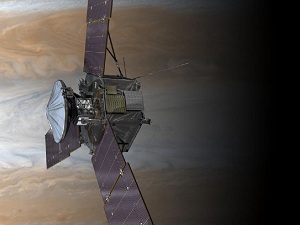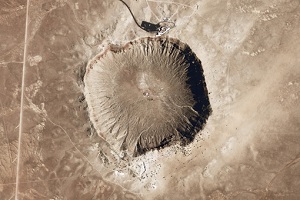Centauri Dreams
Imagining and Planning Interstellar Exploration
Juno: Into the Jovian Magnetosphere
The launch of the Juno spacecraft last Friday gets us back in business around the Solar System’s largest planet, but also has useful exoplanet implications. To understand why, consider just one of the instruments carried aboard the spacecraft. The Jupiter Energetic-particle Detector Instrument (JEDI) is designed to measure how energetic particles flow through Jupiter’s magnetosphere and interact with its atmosphere. Developed at Johns Hopkins Applied Physics Laboratory, JEDI will be looking at the interactions that produce the most powerful auroral phenomena in our system, and what we will learn has broad applications.
After all, new tools like the Low Frequency Array (LOFAR) are coming online, bringing hitherto unavailable sensitivity to radio frequencies below 250 MHz. Not so long ago, Jonathan Nichols (University of Leicester) proposed using LOFAR to look for aurorae similar to those on Jupiter in exoplanetary systems. In fact, his research shows that gas giants in orbits up to 50 AU might be detectable from Earth even if their host star is as far as 150 light years from our planet. That’s a useful addition to our toolkit, for gas giants in wide orbits take a long time to identify using radial velocity methods, which are much more sensitive to the massive tug of a closer in ‘hot Jupiter.’
Image: NASA’s Juno spacecraft is shown in orbit above Jupiter’s colorful clouds in this artist’s rendering. Juno will arrive at Jupiter in 2016 to study the giant planet from an elliptical, polar orbit. The spacecraft will repeatedly dive between the planet and its intense belts of charged particle radiation, coming only 5,000 kilometers (about 3,000 miles) from the cloud tops at closest approach. Credit: NASA/JPL-Caltech.
The first spacecraft designed explicitly for a magnetic mapping mission, Juno will be operating in a tough environment, one in which electrons, protons and ions are energized by the planet’s fast rotation. Other than the Sun, no other destination NASA has visited presents such radiation challenges. In this orbit, Juno will need to take advantage of a protective shield made of titanium to preserve its sensitive electronics. This ‘vault’ weighs about 200 kilograms and should dramatically extend the life of the spacecraft’s instruments. Juno will circle Jupiter’s poles for a year after arrival in the summer of 2016, the choice of orbit adding its own radiation protection — the spacecraft will spend little time in the intense radiation belts around Jupiter’s equator.
The elliptical orbit will bring Juno closer to the giant planet than any other spacecraft, its polar orbits covering the entire globe during the course of an Earth year. At its closest, the spacecraft will feel the full brunt of the magnetic field, some 10 to 12 Gauss (Earth’s field is about half a Gauss), while further out — Juno will range farther out than the orbit of Callisto — it should encounter a field 10 million times weaker. Each of its magnetometers is equipped with two star cameras to determine the sensor’s orientation in space, allowing exquisite accuracy in measurement. Variations in the magnetic field will help scientists visualize how the planet’s magnetic system operates and offer insight into the planetary dynamos of gas giants.
But back to the aurorae and how they are formed. Barry Mauk (JHU/APL) is lead investigator for JEDI:
“JEDI’s sensors will be trained on the higher-energy particles that help to generate Jupiter’s aurora, that heat and ionize Jupiter’s upper atmosphere, and that offer clues to the structure of Jupiter’s near-planet space environment. We really want to know what happens in the aurora that causes these particles to accelerate to such high energies, and Juno will be the first spacecraft to fly within the region where this acceleration actually takes place.”
The polar orbit will be traversed 33 times as the spacecraft uses JEDI and its eight other science instruments and numerous sensors to probe the atmosphere and magnetosphere while looking for signs of a solid planetary core. Steven Levin (JPL) explains how the polar orbiter will be able to do more than simply investigate Jupiter’s active aurorae:
“Mapping Jupiter’s magnetic field is one of the very few ways available to learn about Jupiter’s deep internal structure. That’s because Jupiter’s atmosphere is compressed so much by its powerful gravity field that it becomes impenetrable to most sensing techniques. In addition, Jupiter may be the best place in the solar system to study how planetary magnetic fields are generated.”
In addition to the science instruments, Juno carries three figurines onboard: A 1.5-inch likeness of Galileo Galilei, a statue of the Roman god Jupiter and one of his wife Juno. But a plaque dedicated to Galileo, also on the spacecraft, is what caught my attention. Provided by the Italian Space Agency, the diminutive plaque measures just 71 by 51 millimeters (2.8 by 2 inches) and is made of flight-grade aluminum with a weight of six grams. Bonded to Juno’s propulsion bay, the plaque depicts a self-portrait of the Italian astronomer and also includes a famous passage he wrote in 1610 recounting his observations of the giant planet and its largest moons:
“On the 11th it was in this formation — and the star closest to Jupiter was half the size than the other and very close to the other so that during the previous nights all of the three observed stars looked of the same dimension and among them equally afar; so that it is evident that around Jupiter there are three moving stars invisible till this time to everyone.”
Thus an account of the discovery of large Jovian moons is now on its way to the planet Galileo did so much to reveal to humanity. It’s also worth remembering that Juno will be equipped with three huge solar panels, making it the most distant probe ever to be powered by the Sun. Fully extended, the probe will be over 18 meters wide as it soaks up as many solar photons as possible from a distance of 800 million kilometers from the Sun. We’ll have to learn as much as we can from Juno in relatively short order, for the mission is designed to survive in its Jovian orbit for little more than a year.

Musings on Imperfection (and an Update)
by Marc Millis
It occurred to me, after I wrote the post on impartiality and read the resulting comments , that a few other perspectives need to be shared. These encompass the necessity of inspiring visions, playfulness, complimentary contrasts, and tolerance for imperfection. And following that, I realized it was about time for another status update on Tau Zero.
Perfectionism is a neurosis that runs in my family. My dad had it. I have it. My wife and her mom had it. And now my daughters are dealing with it. I see it in many colleagues too. Perfectionism is when striving for ultimate quality exceeds striving for utility. It occurs most when we succumb to rhetoric about ‘excellence’ instead of utility and creativity. At NASA, the term “gold brick” was used to describe this.
I mention this because I’ve been making those same mistakes again while trying to convert Tau Zero from a volunteer, donation-based network into a fully functioning nonprofit corporation. Many of you have noticed the lack of updates on our public Tau Zero web pages (www.tauzero.aero). We have also not yet succeeded in bringing in sufficient funds to implement our next-step plans. While some of this is due to external circumstances and my learning curve of transitioning from a government worker into an entrepreneur, some of these shortcomings are due to my own perfectionism. I’ve been focusing too much on getting our next-steps “just right” to the point where I have not gotten things done. My apologies to our supporters. With this posting, changes are underway.
While lamenting on our shortcomings, I took comfort in seeing that Tau Zero is not alone in dealing with such issues. The Journal of the British Interplanetary Society has fallen about a year behind schedule and is still catching up. SETI failed to plan for operational funds for their telescope array, even though they succeeded in getting funds to build the array. The Planetary Society did not succeed at launching their first solar sail mission. And then there is Congress’, the President’s, and NASA’s failing to devise a sustainable space program. This also brings back memories from NASA of meetings where more resources were spent trying to eliminate waste than the amount being wasted (comparing labor cost of those meetings to the topic’s dollars).
Such striving for increased efficiency is more prudent and attainable when producing the same product, over and over (Cola?), than it is in these other types of organizations where each are attempting something that has never been done before. Pioneering work and perfectionism are not a healthy combination.
Bottom line, such imperfections are common. I’ll even go so far as to assert that they are an unavoidable consequence of human endeavors, especially those that are charting new ground. That said, it is a part of our human condition that I am still trying to accept in myself. And with that, I appreciate your patience as I bring Tau Zero into a new, more active era.
Where Tau Zero is Today
Here now is a list of activities of Tau Zero and their status.
(1) GRADUATE STUDENT PROJECTS: One of the recent set of comments on Centauri Dreams was about whether to create an “Interstellar Institute.” Since Tau Zero is not yet bringing in the degree of resources needed to create an institute, and because such an entity might not be the most effective way to spur wide-spread progress, an intermediate, alternative tactic is being implemented. Rather than creating one institute, we are looking to encourage graduate students everywhere to take on some of the unsolved, next-step issues of star flight as their thesis and dissertation topics (covering, “What’s out there?” “How to get there?” and “What does this mean for humanity?”). The first such thesis is already underway, at the USAF Institute of Technology.
Finding interested students is easy. Defining suitable thesis topics to consider and then getting my practitioners lined up to help get the students started, is challenging. Establishing working relations with the universities (their advisor must agree to the thesis topic) is even harder. I’ve started establishing working relations with other universities so that we can jointly apply for grants both for the student and to help pay for the services of our assisting practitioners. It is slow going, but things look promising. I feel this tactic will spur greater progress and broaden opportunities overall and for less cost and effort than creating a Interstellar Institute. I know a lot of students have asked about this. Bear with me as we work through the gory details of making it happen.
(2) MEMBERSHIPS: We are preparing to shift Tau Zero from a ‘Donation-only’ forum to one with annual memberships (est $55). This is to help both with revenue generation and to spur a more productively interactive community. Preparations are underway to: Set up the automatic database required for such actions, include volunteer coordination with that information, and create member benefits (newsletter, free downloads of practitioner presentations, and discounts on Tau Zero emblazoned merchandise).
(3) TAU ZERO STORE: In part to offer member goodies, and for revenue generation, and because we’ve been asked over and over again to offer t-shirts, mugs, and patches, we are setting up a store and designing products. We are also working to prepare “special reports” for sale that translate the journal papers that our practitioners publish into more accessible and readable documents for the non-specialist (this is NOT easy).
(4) REVAMPING TZF WEB: The glitch that blocked editing-access to our public website has been fixed, but creating new content is taking longer than expected. Producing content is easy. Producing digestible, meaningful content that is well organized is harder. We have created a private workspace where our practitioners can jointly prepare content in a wiki-style manner for later posting.
(5) ADVANCING THE STATE OF ART: Many of our practitioners keep making progress on interstellar challenges in their day jobs and on their own time. When they publish, Paul Gilster writes about their work, here, on Centauri Dreams. Related to that, we are asking several of the chapter authors from Frontiers of Propulsion Science to submit Centauri Dreams articles about those chapters and any follow-on work. This includes me writing about space drives.
(6) NETWORKING: Although Tau Zero has an abundant collection of space propulsion and power professionals, we are weak in areas of the humanities, and colony ship technology. I hope to meet more people in these disciplines at the 100-Year Starship Symposium. We are also weak regarding simple administrative support, but have recently made some headway there.
Here now is our current list of practitioners. For Tau Zero purposes, the word practitioner has a specific meaning. Practitioners of TZF work together to support the primary mission to pursue advances beyond the focus of other space organizations, using the challenge of interstellar flight as the driver for revolutionary progress. It is desired that practitioners follow their own instincts and make progress in their respective disciplines. When more than one practitioner shares the same interest/discipline, we urge collaboration to avoid duplication of effort. Better still, we suggest pooling of resources to make more of an impact.
ALSO – here is the opportunity to mix disciplines. For example, to convey complex sci-tech to the public in a responsible manner (factual, non-sensationalist, and absent hype or disdain), the journalists and artists on this list are willing to help the scientists and engineers. Reciprocally, the journalists want better content for their work and can call upon the scientists and engineers here for trustworthy content. Eventually, the suite of practitioners will cover the full gamut of topics pertinent to starflight, yet at present we are underrepresented in many key disciplines, such as colony ship requirements / technologies, the humanities, finance).
Tau Zero Practitioners
- Karen Anderson: Humanities, science fiction community networking (widow of Poul Anderson, author of Tau Zero)
- Dana Andrews: Technology, system level engineering and trend analysis
- Greg Bear: Humanities, science fiction writer
- James Benford: Technology, power beaming
- David Brin: Humanities, science fiction writer, provocateur
- Jean-Luc Cambier: Physics
- Brice N. Cassenti: Mathematics and engineering
- Adam Crowl: Mathematics and engineering
- Eric W. Davis: Physics with specialties in FTL, general relativity and the quantum vacuum
- Walter de Brouwer: Board member, fundraising, networking
- Kathryn Denning: Humanities, anthropology
- Robert H. Frisbee: Technology, comparative assessments
- Pat Galea: Project Icarus IT support
- Paul Gilster: Board member, Lead Journalist, and humanities, public education
- George Hathaway: Experimentalist
- Steven D. Howe: Technology, nuclear propulsion & power
- Jonathan Hujsak: Admin assistance, lead IT for Tau Zero
- Gerald P. Jackson: Physics, antimatter & nuclear
- Les Johnson: Technology, sails and advanced propulsion, and humanities, writing books for public education
- Jordin Kare: Technology, system level analyst
- Larry Klaes: Humanities, journalism & social networking (TZF Facebook fan site maintenance)
- Geoff Landis: Physics, and humanities, science fiction author
- Michael R. LaPointe: Technology and physics, specialty in electromagnetics
- Tim Lawrence: Liaison & assistance, USAF networking
- Kelvin Long: Project Icarus founder, liaison British Interplanetary Society
- Claudio Maccone: Mathematics (specialty in transforms & statistics), and project on statistical Fermi-Drake estimations as well as FOCAL mission studies
- Jordan Maclay : Physics, specialty in quantum vacuum and Casimir experiments
- Geoff Marcy: Astronomy, specialty in exoplanet hunt
- Gregory Matloff: Technology, specialty in interstellar probes, and humanities, writing books for public education
- William V. Meyer: Physics, experimental, small scale
- Marc G. Millis: Board, founder and Executive Director, and physics, specialty in space drives
- Frank P. Nagorney: Board, legal issues
- Robert J. Noble: Technology, secondary propulsion
- Richard Obousy: Project Icarus, physics
- Tibor Pacher: Humanities, social networking, Faces from Earth project
- Bob Romanofsky: Technology, specialty in sensors
- Aldo Spadoni: Humanities, technology, art and documentaries
- Alexandre Szames: Humanities, Lead Artist for Tau Zero, history, journalism
- Martin Tajmar: Physics and advanced propulsion
- Andreas Tziolas: Project Icarus, physics
- Edward Zampino: Physics and mathematics
(7) FUND RAISING: The first solicitations to seek philanthropical support went out in 2010 and lessons were learned in that process. Changes are being applied now for future solicitations. I am new to this process and the learning curve is an uphill struggle.
(8) ETC: And lastly, we are responding to all the unexpected things that have come up, like the 100 Year Starship study, the reemergence of NIAC, various conferences, etc. More news on all these things will follow.
Stay with us — we plan to be here for the long haul.

BIS Conference Highlights Worldships
Talking about Mason Peck’s notions of ‘swarm’ spacecraft — probes on a chip that might reach interstellar speeds — I’m inescapably drawn to the other end of the spectrum. A ‘worldship’ is a mighty creation that may mass in the millions of tons, a kilometer (or more) long vehicle that moves at a small fraction of the speed of light but can accommodate thousands, if not hundreds of thousands, of inhabitants. What promises to be the first scientific conference devoted solely to worldships is about to take place on Lambeth Road in London at the headquarters of the British Interplanetary Society. The day-long conference gets down to business on the morning of August 17. This BIS page offers a draft of the program.
As the BIS has done in the past, all presentations from the conference will be written up in a special issue of the Journal of the British Interplanetary Society, where much of the early speculation on worldships has taken place. Several of the Project Icarus team will be presenting papers and I notice that solar sail expert Gregory Matloff, one of the analysts of worldship ideas in the pages of JBIS back in the 1980s, will be represented with a paper on sail options for such a mission. Beyond that, the conference aims, in the words of its organizers, “to reinvigorate thinking on this topic and to promote new ideas.” It will “focus on the concepts, cause, cost, construction and engineering feasibility as well as sociological issues associated with the human crew.”
Image: A worldship may eventually take shape by drawing on the design of space habitats built closer to home. Credit: Don Davis.
Those of you who are familiar with The Starflight Handbook, Matloff’s seminal work on interstellar concepts (John Wiley & Sons, 1989) may recall a write-up on a mission called Sark-1, described as a ‘solar sail interstellar ark’ and named in honor not only of the sailing vessel Cutty Sark but the whiskey that now bears its image. The latter reference is a nod to the fact that a generous store of spirits would not go amiss for those involved in a journey scheduled to last at least a thousand years.
The Sark-1 would be, in comparison to some of the behemoth worldship concepts that have followed, a relatively small vessel, carrying a ‘modest’ crew of 1000 to the Alpha Centauri system. Working with Eugene Mallove, Matloff went on to allot roughly 40 square yards of living space for each person, lodged within a toroidal cabin structure that would weigh 2500 metric tons on the Earth’s surface. Now figure 1000 tons of atmosphere, supplies and power plant adding up to 2000 tons, giving you a basic 5500-ton space colony minus the essential sail. The authors then round the number up to 10,000 tons, thus providing for supplies needed upon arrival.
You make a lot of assumptions when trying to design something that only futuristic technology can deliver. Matloff and Mallove divide the colony into a fleet of six starships, each towed by a circular sail 380 kilometers in diameter, and assume micro-fine filaments of diamond for support cables. For propulsion, a close solar pass would involve an initial perihelion velocity of 0.0014 c, making travel time to Alpha Centauri about 1350 years. The sail — folded and stowed during the cruise phase — would be redeployed upon approach to the Centauri stars, electrically charged and used for deceleration. What the authors say next meshes nicely with the upcoming conference:
Missions by solar sail starship habitats lasting millennia may never be attractive to terrestrials. However, long-term residents of space colonies in the solar system or members of other spacefaring civilizations in the galaxy may not feel equally constrained. Furthermore, as we have seen, there may be undiscovered stars much closer than Alpha Centauri, so we may eventually discover destinations only a few centuries away via inhabited solar sail starships. So in addition to research on solar sail materials, starship dynamics, and logistics, it is not too soon to undertake sociological studies of the problems of maintaining interstellar colonies. Whether clipper ships of the galaxy will ply the interstellar ocean in the twenty-first century, as white-sailed Yankee clippers once did in the nineteenth, is a question our children may be able to answer.
Moving well beyond Sark-1, a true worldship would need to approximate a terrestrial environment inside a far larger vessel. The idea, after all, is to deliver a population of colonists who are not only equipped for the job but sane enough to accomplish it. That may well require structures on the scale of an O’Neill habitat, gigantic vessels housing many of the amenities we take for granted on a planetary surface — parks, lakes, farms — with ample room for living and carrying out a rewarding life as the interminable journey progresses. The typical Earth-dweller isn’t designed for such a mission, but long-term colony structures in the Solar System may one day breed a population for which living on a planetary surface is something of an anomaly. Will the descendants of this kind of habitat head out to become our first interstellar colonists?
For more, see Matloff and Ubell, “Worldships: Prospects for Non-nuclear Propulsion and Power Sources,” JBIS 38 (June 1985), pp. 253-261. See also Matloff and Mallove, “The First Interstellar Colonization Mission,” JBIS 33 (March, 1980), pp. 84-88.

Periodic Impact Events: A Critique
One of the more intriguing issues for the Wide-field Infrared Survey Explorer (WISE) satellite is the question of nearby objects that might be causing problems with the Oort Cloud. Specifically, we’re interested in learning whether an object like the hypothesized ‘Nemesis’ — a tiny companion star to the Sun — or a closer gas giant (‘Tyche’) — might cause disruption to cometary orbits that would create episodes in which more comets than usual make their way into the inner Solar System. Find such an object and you may be able to explain what some have been arguing, that there are periodic variations in the timing of giant impacts, a regular and revealing pattern.
Of course, periodic changes in the frequency of impacts could be caused by something other than a companion star or unknown planet. Another suggested mechanism is the motion of our Solar System through the main plane of the Milky Way, causing the gravitational influence of nearby stars to tug on Oort Cloud comets on a repeated basis. In both cases, we’re wondering whether the age estimates for various craters shows us a pattern, something that tells of impact cycles varying between 13 and 50 million years depending on which theory you look at. Earth would have long periods with few impacts and then a wave of increased impact activity.
Image: Barringer Crater, also known as Meteor Crater, in Arizona. This crater was formed around 50,000 years ago by the impact of a nickel-iron meteorite. Near the top of the image, the visitors center, complete with tour buses on the parking lot, provides a sense of scale. Credit: National Map Seamless Viewer/US Geological Service.
Enter Coryn Bailer-Jones (Max-Planck-Institut für Astronomie), whose new work in Monthly Notices of the Royal Astronomical Society argues that perceived periodic patterns in impact activity are nothing more than a statistical artifact. In other words, the idea that there is an ebb and flow to cometary strikes is not actually found in the data. This does not mean the situation is static. Bailer-Jones says there may be a slight increase in impact events over the past 250 million years under this scenario, but a long-term pattern of periodic variability does not appear in his analysis.
He goes on to argue that the evidence for disruptions of the Oort Cloud relies on a problem with traditional statistical reasoning, saying “There is a tendency for people to find patterns in nature that do not exist. Unfortunately, in certain situations traditional statistics plays to that particular weakness.” The problem, explored in this MPIA news release, is that those studying periodicities in impact crater data have to take into account whether the periodicity they are testing against was derived from their data in the first place or posited independent of observation. If the latter, the argument can be flawed because a bias has been introduced from the outset. That bias operates against the ‘null hypothesis’ against which the periodicities would be measured.
The alternative chosen by Bailer-Jones is to work on the problem through Bayesian statistics, an approach that begins with multiple hypotheses and uses the data to adjust the probabilities for each. I am no statistician, and my hope is that some of the more mathematically inclined of our readers will have a go at the paper to tell me how sound Bailer-Jones’ conclusions are. In any case, the point is that in all the data sets, periodic variation in cratering is disfavored, and the author argues that the craters we see on Earth do not suggest regular waves of impact events:
“From the crater record there is no evidence for Nemesis. What remains is the intriguing question of whether or not impacts have become ever more frequent over the past 250 million years.”
The latter issue is interesting because such an increase in impact rates would, in Bailer-Jones view, make the usual null hypothesis assuming constant impact probability invalid, thus calling into question any study that finds a periodic change in impact events. So instead of periodic variations in impacts, we’re looking at a trend within the past 250 million years of a steady increase in such events. This may in turn be explained by the fact that smaller craters erode more easily, and older craters have more time to erode away. In other words, larger and younger craters are easier to find than smaller, older ones. The question of whether the increase in impact activity is real, then, may have to be resolved by looking at impact craters on the Moon, where there are no natural processes at work that can lead to craters being filled and eroded.

Image: The Nördlinger Ries, or Ries, was formed when a meteor hit the area 15 million years ago. The resulting crater, roughly 20 km in diameter, has since been filled in and eroded. In this natural-colour satellite image, it can just be made out as a circular structure, much less clearly defined than the Barringer Crater, which is significantly younger. Credit: NASA/J. Allen using data provided courtesy of NASA/GSFC/METI/ERSDAC/JAROS, and U.S./Japan ASTER Science Team.
WISE data should eventually give us the definitive word on large objects in nearby space. Until then, Bailer-Jones’ work is, “Bayesian time series analysis of terrestrial impact cratering,” Monthly Notices of the Royal Astronomical Society, published early online 27 June, 2011 (abstract).

Vesta: A New World Being Revealed
Considering the nature of the Dawn spacecraft’s slow, spiraling entry into orbit around Vesta, it’s a little unclear precisely when orbital insertion was, but NASA is pegging an approximate time of 0447 UTC on July 16. The event is leading to closer and better imagery all the time, the example below being the first full-frame image, taken from the spacecraft’s framing camera on July 24. Here we’re looking at the asteroid from a distance of 5200 kilometers, seeing for the first time the kind of surface detail that has long been hidden from even the most powerful telescopes.
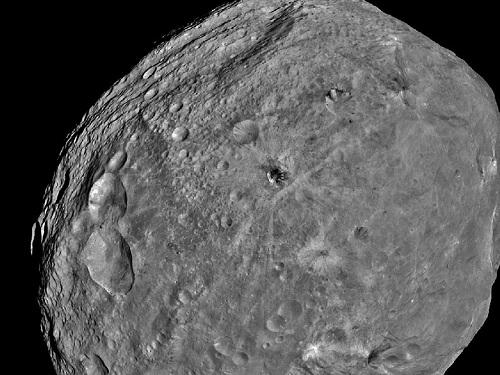
Image: NASA’s Dawn spacecraft obtained this image of the giant asteroid Vesta with its framing camera on July 24, 2011. Credit: NASA/JPL-Caltech/UCLA/MPS/DLR/IDA.
Dawn’s principal investigator Chris Russell (UCLA) likes what he sees:
“We have been calling Vesta the smallest terrestrial planet. The latest imagery provides much justification for our expectations. They show that a variety of processes were once at work on the surface of Vesta and provide extensive evidence for Vesta’s planetary aspirations.”
We’re going to be learning quite a lot about both Vesta and Ceres from coordinated work between the spacecraft’s radio transmitter and Earth-bound antennae, which will be used to monitor signals from Dawn to detect variations in the asteroids’ gravity fields. The intent is to learn more about the interior structure of the two objects. We’ll also use Dawn’s visible and infrared mapping spectrometer to measure the surface mineralogy of both asteroids. Dawn’s first of four intensive science orbits of Vesta will begin on August 11 at an altitude of 2700 kilometers.
A spectacular view of the rotating Vesta is offered in the following video:
Image: In this movie, strung together from a series of images provided by the framing camera on NASA’s Dawn spacecraft, we see a full rotation of Vesta, which occurs over the course of roughly five hours. These images were obtained on July 24, 2011, from a distance of about 3,200 miles (5,200 kilometers).
And let’s close with a closeup of craters in the southern equatorial region:
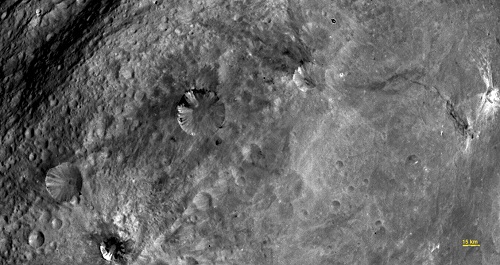
Image credit: NASA/JPL-Caltech/UCLA/MPS/DLR/IDA.

A Swarm of Probes to the Stars
Just how big does a spacecraft have to be to do productive work? It’s a provocative question in this era of CubeSats and downsized budgets, but when you start thinking interstellar, there are even more reasons to wonder how small you can make your vehicle. After all, the propulsion challenges facing interstellar missions are profound, and the more mass (including, of course, the fuel you’re carrying), the greater the problem. The rocket equation is telling, and one of the many things it tells us is that trying to reach a nearby star with a conventional rocket is out of the question, at least if you’re hoping to get your mission there in a reasonable century or so.
Mason Peck has been pondering issues like this for a long time. Those of you who are unfamiliar with his work at Cornell can catch up by reading earlier Centauri Dreams posts, but a more current solution is the article Exploring Space with Chip-sized Satellites, which runs in the current issue of IEEE Spectrum. In it, Peck looks at the way our probes have grown over the years, from the Herschel Space Observatory’s 3.5-meter telescope to Cassini’s 11-meter magnetometer boom, and goes on to discuss a far different idea: The creation of spacecraft the size of dust motes, probes that operate in swarms, with not just interplanetary but interstellar reach.
Spacecraft on a Chip
So instead of the Enterprise, let’s imagine a microchip 20 micrometers thick and weighing 7.5 milligrams. We’re talking about tiny solar sails — Peck calls these ‘Sprites’ — that would have the right ratio of surface area to volume to accelerate at about 0.06 mm/s2, making them about ten times faster than the Japanese IKAROS sail. Now we’re in range of interplanetary missions for tiny spacecraft that can carry a single sensor each. Think of each ‘chip probe,’ though, as just one node that operates along with a multitude of such chips to form a distributed sensor network in space.
Here’s one local use, as Peck explains in his IEEE Spectrum article:
We could, for instance, send tens of thousands of Sprites into orbits between Earth and the sun. These simple chips would have one task: to send a signal to Earth when the local magnetic field or the number of charged particles that hit the spacecraft exceeded some threshold. Taken alone, each chip would provide just one data point. But a network of these scattered chips could produce 3-D snapshots of space weather, something no traditional spacecraft, no matter how sophisticated, could ever do on its own. A payload of a million of the relatively heavy 50-mg version of the Sprite would amount to just 50 kilograms, about the mass of a single science instrument on one of NASA’s larger interplanetary spacecraft. So the launch costs of a Sprite network would be significantly lower than that of a traditional satellite.
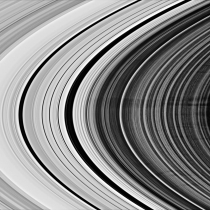
Peck is working on prototypes for such chips, about which more in a moment, but Centauri Dreams is drawn to the interstellar consequences of his work in the long-term. And on that score, today’s small chip prototypes point to an interesting propulsion option. For the Sprites are of such low mass that they should be able to take advantage of the magnetic fields around planets. The Lorentz force affects charged particles that move through a magnetic field, an effect that shows up in the famous ‘spokes’ that cut across Saturn’s rings, the result of the ionization of dust particles by virtue of sunlight and plasma effects and the consequent forces of the planet’s own magnetic fields on the ionized dust.
Image: Spokes in Saturn’s B-Ring, Cassini-Huygens Mission. Credit: NASA/JPL.
Taking the Sprite Interstellar
Now think about harnessing the Lorentz force around a still larger Solar System planet. Jupiter’s magnetic field is 20,000 times stronger than the Earth’s, and could be used as a natural particle accelerator. To do this, each Sprite would need an electric charge, easy enough to create with the help of plasma in a planetary environment (Peck has been testing the process at Cornell by exposing Sprite-sized objects to a stream of xenon plasma). A charged Sprite would use the Jovian magnetic field to accelerate itself in orbit, reaching thousands of kilometers per second, before turning off its onboard power supply, at which point the Lorentz force disappears and the spacecraft is hurled at high velocity out of the Solar System.
Time to Alpha Centauri? Perhaps a few hundred years, but that’s much faster than the best solar sail ideas, which have trouble reaching below a thousand years for the journey. And as with solar sails, we can also consider the possibility of using a laser assist to power the tiny sails to much higher velocities. Ten percent of the speed of light becomes possible in this scenario, and that gets you to Alpha Centauri space in a more than manageable forty-plus years.
All kinds of questions crop up in this work, not the least of which is the communications capability of the Sprite swarm, and issues of the environment the Sprites move through:
Sprites will also be far more vulnerable to damage than present-day spacecraft. Because they are lightweight and have solar cells built directly on the chip, Sprites can’t be equipped with radiation shielding to protect their electronics. This lack of shielding also makes the chip more vulnerable to impacts with micrometeorites, which zip at high speed throughout the solar system. Sprites could compensate for these hazards through sheer numbers; missions could be designed so that a significant fraction of the chips could be lost without dooming the operation.
But issues like these are also what Peck is working on both at Cornell and through experimentation at the International Space Station. There, Sprite prototypes have been mounted on the exterior of the ISS, each containing solar cells, a microprocessor with radio, an antenna and amplifier and the necessary switching circuitry. With little power to work with, the transmitters will produce only the weakest of signals, so the current work focuses on code-division multiple access (CDMA) techniques to help pull signal out of the noise.
![]()
Image: There are currently two Sprite prototypes being tested: a Printed Circuit Board version and a Multi-Chip Module developed through a collaboration with Sandia National Laboratories. These are both traceable to an objective ‘System on Chip’ prototype. Credit: Mason Peck/Cornell University.
A Future in the Swarm
The overall project looks at the physics of tiny objects and the uses of mass production, and the concept echoes similar notions in play in the computing community:
The idea goes back at least 15 years, and it has its origins in “smart dust”—tiny microelectromechanical sensor systems that can be used to measure light and temperature, register movement and location, and detect chemical and biological substances. The notion of sending such systems into space was slow to gain momentum. But it began to take off once space researchers realized that integrated circuits had become quite inexpensive, dense, and easy to fabricate, and that almost everything a spacecraft needs can now be made with semiconductors alone: solar cells for power, capacitors for energy storage, and all the memory and processing capability you could want. As with smart dust, a diversity of payloads can be fabricated to ride on a chip, including basic spectrometers, load sensors to measure particle impacts, chemical sensors, and simple CMOS cameras. Researchers around the world, including groups at Surrey Space Centre, the University of Strathclyde, the Aerospace Corp., and the Jet Propulsion Laboratory, have explored the possibility of making chip-based spacecraft and are investigating their capabilities.
What a notion. We can couple these ideas with hoped-for advances in nanotechnology that may take Sprite concepts down to far smaller scales. I remember talking to Robert Freitas when writing Centauri Dreams (the book) about his idea of intelligent ‘needle’ probes, tiny interstellar craft spewed into the deep by the millions, each containing the assembler technology that would allow it to harvest local materials in a planetary system to build the necessary scientific station upon arrival.
Mason Peck’s Sprites would seem to have real possibilities here in the Solar System (imagine a swarm floating in the clouds of Titan to provide ongoing analysis of that distant world), and we can only speculate about their possibilities for interstellar missions. But moving out of the era of the huge space vehicle with gigantic fuel tanks into the realm of the miniature takes us in a direction that offers real potential for the kind of propulsion that could reach a nearby star. And as our work at nanotechnological scales advances in coming decades, we may learn how to solve some of the seemingly intractable communications problems such probes would face.
For more, see Atchison and Peck, “A Millimeter-Scale Lorentz-Propelled Spacecraft,” AIAA Guidance, Navigation and Control Conference and Exhibit 20 – 23 August 2007, Hilton Head, South Carolina, AIAA 2007-6847 (available online). See also M. Peck, B. Streetman, C. Saaj and V. Lappas “Spacecraft formation flying using Lorentz Forces,” Journal of British Interplanetary Society, Vol. 60, No. 7, pp. 263-267, July 2007.

